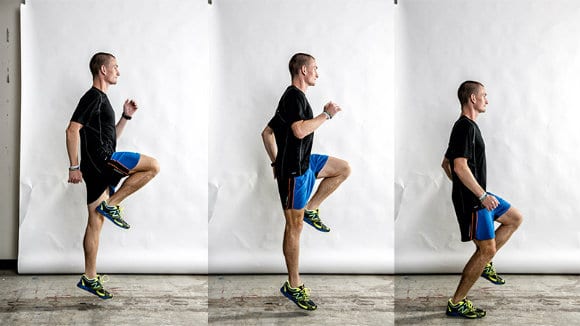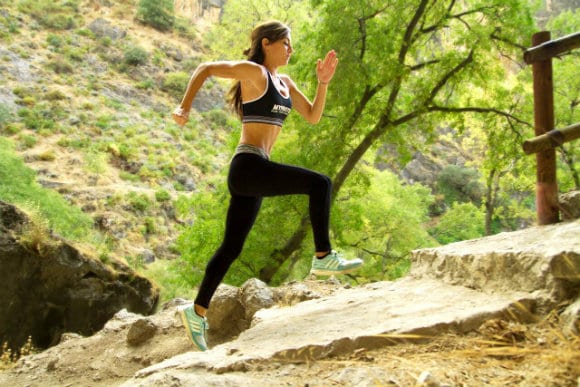By the healthiergang writer , student in Pharmacy.
Skip
The skip is a particular type of running in which the strides provide for an evident lifting of the knees compared to the ordinary movement; for this reason it is often referred to as a "high knee race".
The importance of this exercise is often underestimated, if not in the world of running and athletics in general, where it is always present in the training programs of athletes.
Thanks to the skip, in fact, the sportsman will be able, over time, to improve their physical performance, especially in terms of technique, speed, strength, endurance and coordination.
How is it practiced?
Before starting you have to make sure you are ready for the exercise, performing heating and stretching if necessary.
Footwear is essential, and must be specially designed for running, therefore cushioning, low, and not stiff and too high.
Then a the terrain must be assessed: this in turn must be regular, and possibly "soft"; the ideal would be a grassy ground, but it is also possible to perform it in the gym, preferably avoiding asphalt or uneven surfaces, to reduce the risk of microtraumas.
At this point you can start the exercise.
The torso and head are kept the more vertical the more the knees rise in the skip movement; therefore in a high skip we will have vertical torso and head, while in the low skip they will be slightly inclined forward.

The shoulders are kept still throughout the execution of the movement; the arms should be kept close to the hips, and moved in opposition to the legs; this means that when we lift the left leg, we will bring the right arm forward, and so on.
Crucial moment is undoubtedly the push: this must involve only the forefoot, and once performed, this must be brought forward immediately, without passing close to the buttock (which instead happens in normal running).
How much to lift the leg? In the high skip the knee reaches hip height, while in the low skip it stays a little lower.
The abdominals must be kept contracted, as they represent the central nucleus of the movement.
Muscles involved
The skip involves the thigh flexors and all the muscles of the leg-foot segment, in particular calves, quadriceps, lumbar and abdominals.
Although due to the peculiarity of the movement it cannot be considered a complete warm-up exercise (and therefore for this purpose it must be accompanied by complementary exercises), it is excellent for preparing for performance and to allow, especially young athletes, to become aware of their own body.
Skip movements are great to be included in any training program, especially HIIT and the like.
variants
The variants of the skip are numerous.
First of all you can intervene on the height of the knee, and therefore we could perform high skip or low skip, described above. Another variable inherent to the stride is that of amplitude: a very advanced skip, to be performed only if you have the right levels of preparation and elasticity, is the "wide" one, with legs that are more apart.
So we could intervene on the direction: in fact normally the skip is performed forward, but it can also be performed on the spot, backwards or to the side.
Obviously the various skip techniques can be included in the same workout, in the same series and in the same circuit; we could in fact start with a type of skip and vary the same during the exercise; we could also modify our path by placing obstacles to get around (eg cones).
Advanced skip techniques see the execution of movements in which instead of raising both legs alternately, only one leg is raised, for a defined number of repetitions, and then also passes to the other.
Finally, to bring the exercise to a further level of difficulty it is possible to perform it with an overload: for this purpose we could use:
- Specially designed rubber bands.
- A lifting belt connected to a certain weight.
- Cuffs and / or anklets with weights.
Since under the term “skip”, which literally means “to jump”, “to jump”, there are many exercises - even very different from those described above - we see below the most common, useful and effective ones.

Jumping or jumping: jumps are performed in which the propulsive limb is extended in the thrust phase, and is immediately lifted forward. The thrust must lift the body up and forward.
Forward Kick Run: unlike running with high knees, the movement of the leg is represented by a sort of "kick", which can be performed with the leg straight or not. Another variation is the back kick run, in which the feet end up touching the buttocks.
Double impulse: The legs push the body with a bouncing motion, being stretched at the lowest point, and raised at the highest point. Peculiarity of this exercise is represented by the feet, which touch the ground at the same time, with one leg straight (the leg that pushes) and one that brings the knee upwards. Great for responsiveness and coordination.
Finally we remember i gallop and jumping, excellent movements to complement the previous ones.
Common mistakes
- As previously mentioned, uneven and particularly rigid terrain must be avoided, and suitable, comfortable and shock-absorbing shoes must be worn.
- Before starting the skip, but more generally any exercise, it is essential to be ready to perform it; therefore it is necessary to perform the right warm-up and the appropriate stretching.
- Especially for the first few times when you try a skip, you must avoid overdoing it, inserting the exercise with progression in our program.
- Wear comfortable clothing that does not hinder and restrict movement.
- Perform stretching exercises at the end of the workout.
Conclusions
The skip exists in numerous variations that can be included in any training program, according to your needs and goals. It is a fundamental exercise, recommended for all those athletes who want to improve their athletic performance, in particular running and coordination of movements.


























